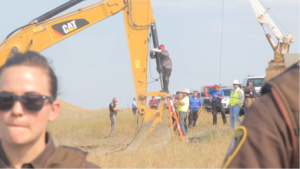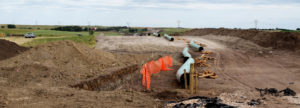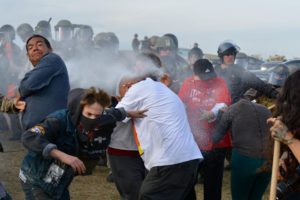The Native-American-led protest against an oil pipeline near Sioux lands in the Dakotas drew international attention and support from U.S. vets, prompting the U.S. Army Corps of Engineers to seek a different route, reports Dennis J Bernstein.
By Dennis J Bernstein
In at least a temporary victory for the Standing Rock protesters, the U.S. Army Corps of Engineers blocked plans for running the Dakota Access Pipeline across Lake Oahe and began to examine alternative routes, although it is unclear how the incoming Trump administration will proceed.
The 1,200 miles Dakota Access Pipeline, owned by Texas-based Energy Transfer Partners LP, is largely complete, except for a segment planned to run under Lake Oahe, a reservoir formed by a dam on the Missouri River, the longest river in North America.
In a statement, Standing Rock Sioux Tribal Chairman Dave Archambault II said the tribe welcomed the decision as very good news, but he also sounded a note of concern regarding what might happen after Jan. 20. He urged President-elect Donald Trump to “respect this decision and understand the complex process that led us to this point.”

The #NoDAPL water Protectors took non-violent direct action by locking themselves to construction equipment. This is “Happy” American Horse from the Sicangu Nation, hailing from Rosebud. August 31, 2016 (Desiree Kane, Wikipedia)
Archambault II went on to say, “When it comes to infrastructure development in Indian Country and with respect to treaty lands, we must strive to work together to reach decisions that reflect the multifaceted considerations of tribes. Treaties are paramount law and must be respected, and we welcome dialogue on how to continue to honor that moving forward. We are not opposed to energy independence, economic development, or national security concerns but we must ensure that these decisions are made with the considerations of our Indigenous peoples.”
Jo-Ellen Darcy, the Army’s Assistant Secretary for Civil Works, told reporters, after talking with tribal officials and hearing their concerns that the pipeline could affect a crucial source of drinking water, it became “clear that there’s more work to do. The best way to complete that work responsibly and expeditiously is to explore alternate routes for the pipeline crossing,” Darcy said in a statement released by the Corps of Engineers on Sunday.
U.S. Secretary for the Interior Sally Jewell said in a statement that the “thoughtful approach established by the Army [on Dec. 4] ensures that there will be an in-depth evaluation of alternative routes for the pipeline and a closer look at potential impacts” and “underscores that tribal rights reserved in treaties and federal law, as well as Nation-to-Nation consultation with tribal leaders, are essential components of the analysis to be undertaken in the environmental impact statement going forward.”
“Our prayers have been answered,” National Congress of American Indians President Brian Cladoosby said in a prepared statement. “This isn’t over, but it is enormously good news.”
Meanwhile, veterans from all branches of the United States Armed Forces have been arriving for days at Standing Rock to join in the anti-pipelin protest. They came in waves of buses, cars, trailers and even planes, to offer their support to the tribes in its many months-long resistance to protect its drinking water and sacred sites. Many believe it was this flood of veterans from many wars that the Army Corps’ hand to decide in favor of the Standing Rock Tribe.

Activists carry the American Indian Movement flag at a protest against the Dakota Access Pipeline. Seatte, WA; September 16, 2016. (Flickr John Duffy)
Anthony Gonzalez, Executive Director of the American Indian Movement (AIM) was at Standing Rock, where he had helped to deliver solar panels to “sustain the resistance” through the long, often brutal, North Dakota winters.
Gonzalez said there were tears of joys in his eyes: “Our hearts soar like an Eagle’s having heard this very good news.” Gonzalez himself is a Vietnam veteran who was awarded the Bronze Star and two Purple Hearts.
Just before the decision came down from the Corps, I spoke with Matt Howard – co-director of Iraq Veterans Against the War (IVAW) and one of the veteran organizers who has joined the resistance at Standing Rock. Howard told me that by Sunday evening over 2,000 vets had converged at the multiple Standing Rocks Camps, despite the sub-freezing weather and all the hardships that go along with it.
Dennis Bernstein: Thanks for joining us from Standing Rock, Matt Howard. Tell us why you traveled there with thousands of other vets.
Matt Howard: Thanks for having me. … I can say for myself that Standing Rock has felt like a real important moment in convergence, to push back on the kinds of militarism that we’re seeing that’s coming home.
Both in the ways the police departments are militarized, but also the way the corporations are utilizing their own kind of private military, to push their extractive industries. … I think that for myself and my organization and my community, we’ve been really monitoring this because it’s frustrating.

The Dakota Access Pipeline (under construction) near Campbell, South Dakota. July 1, 2016. (Flickr Lars Plougmann)
It’s frustrating to see people exercising a legitimate form of protests because they want to have a decent livelihood. And the entire state of North Dakota, in conjunction with what seems like could be federal agencies at times, and then obviously the Energy Transfer partners. It’s kind of disgusting….
I think that what feels really powerful, to me, is that this is potentially the first time that veterans and military members have stood on the right side of this kind of struggle, and are standing on the side of indigenous communities. And veteran communities of indigenous folks are really holding it down and we’re going to be out here, really following their leadership.
DB: Tell us a little bit about how this plan came together. I know that there are veterans from all over the country… are there hundreds? Or are thousands coming? Help us understand, get a picture of what the plan is and what’s going [on].
MH: Yeah, the numbers that we’re hearing are in the thousands. IVAW didn’t put out this call originally, we decided to join it. I think a number of different folks kind of put the call out… veterans of recent wars. And the response has just been … nothing less than amazing. And we have our own community coming out, about 50 folks … joining a much, much larger contingent.
And I think that what has been really important to see, is that the crew that’s coming out is really looking to follow the leadership of the Oceti Sakowin headsmen and the tribe, to really be doing what is going to best serve them in the fight against these pipelines.
DB: So I’m sure that the vets will follow in the footsteps, if you will, of the youth and the elders who have demonstrated an extraordinary amount of restraint, non-violence and prayer, on behalf of themselves and all of the folks, including the police there.
… Speaking in terms of your experience as a veteran, I was there for a protest that actually went into the city, went to the federal building, and there were circles of prayer. And in the middle of the circles, one indigenous veteran, one Native American veteran after another, talked about their experiences, in terms of going to foreign countries, Vietnam, Iraq, Afghanistan, and fighting for all the people, in sort of appealing in that context. Do you want to talk a little bit about that?
MH: I think that there’s something important [happening] … This is a prayer camp, I’m sure you’ve heard that a number of times, and this is… what we have come to understand and learn is that this is a spiritual movement.
And there is something about the way that Standing Rock is almost being treated as an occupied country, similar to Iraq, similar to Afghanistan. Being able to learn more about the land and have a sense of place, that I probably haven’t had in any other place I’ve been to, has been really important.

Security forces protecting the Dakota Access pipeline construction spray protesters with pepper spray. (Photo by Tim Yakaitis)
… My friend and I, who’s a combat medic from Iraq, when we first came into the camp, in the night, we felt like we were coming onto a forward op invasion in Iraq. It was almost indistinguishable, because of the militarization [that] the Energy Transfer Partners and the Morton County sheriffs have really brought to this place. Spotlights everywhere, concertina wire over on the line, barricades, helicopters and planes buzzing overhead all night long, all day long.
So I think that that’s kind of some of the contradictions [that] are playing out here and I do think that in a lot of ways, what I’ve heard a lot about in terms of this veterans mobilization, is the potential … ready for this to be a real [UNCLEAR 07:03] for folks.
DB: And you … make that parallel structure between what you saw… and also in the actual treatment in dealing with people in a way that one gets a sense that they think [the protestors] are less than human. The idea that people were put in these little outdoor cages, and had their alleged crimes written right on their bodies is pretty profound.
MH: Absolutely. And, you know, I think that despite that kind of ugliness, it’s really amazing to see the power of folks really coming together, being led… this being an indigenous led movement, and really coming from a place of prayers as people unite. And I keep hearing… and it’s kind of been amazing to see, despite the violence that’s been brought to people, people are coming here and are digging in because they know how important the struggle is. And they’re doing it in a way that is rooted in their traditions.
DB: … We know now that it’s sub-freezing weather, it’s a snow storm [at the Standing Rock camp]. We’re getting reports that the law enforcement is attempting to stop the folks from bringing in supplies. What do you know about that?
MH: Yeah … I know some folks that … did not have supplies get confiscated but definitely got fined for bringing supplies in. We had heard reports of people actually getting gear that looked like it was coming to supply the camp was literally being confiscated, which is obviously entirely illegal.
DB: You mean, they were just pulling people over and taking the stuff?
MH: That’s the reports that we had heard, yeah. It felt like…you know, that’s a blockade, right?
DB: It sounds like a blockade. Military again, huh?
MH: Right, exactly. But I think that when the public pressure kinda came… there started to be more awareness of that, they dialed back, and they have been fining people. I believe I saw something recently that the ACLU is already on that. But, you know, they’re trying to find tactics to disrupt the flow of people, and resources, to this camp.

Activists gather in Seattle to protest the Dakota Access Pipeline, September 2016. (John Duffy Flickr)
DB: And help us, before we say goodbye, help us put a human face on this. What’s going on at the camp now. Is there a lot of building, a lot of preparation? I know we were there just before the snow storm hit, and people were incredibly focused and engaged, in preparing for a very difficult winter. How would you describe the situation? What does it look like, are people ready?
MH: Yeah, I think so, for the most part. You know, there’s been a lot of winter preparations that happened before we got here. There are definitely folks that have the kind of three season tents, or worse, that were not prepared for a snowstorm, but fortunately there are a lot of communal sleeping tents, that were set up for people.
And … I’ve told people recently … that definitely we need wood/propane because it has been cold. Fortunately, this snow storm has let up. But, you know, because of the collective spirit of this camp, folks that aren’t as prepared are being taken care of. If they don’t have the kind of gear they need, they’re being provided with. Despite that, we definitely encourage anybody who is planning on coming out to not just come here prepared but come here to leave things.
Dennis J Bernstein is a host of “Flashpoints” on the Pacifica radio network and the author of Special Ed: Voices from a Hidden Classroom. You can access the audio archives at www.flashpoints.net.

“Jo-Ellen Darcy, the Army’s Assistant Secretary for Civil Works, told reporters, after talking with tribal officials and hearing their concerns that the pipeline could affect a crucial source of drinking water, it became “clear that there’s more work to do. The best way to complete that work responsibly and expeditiously is to explore alternate routes for the pipeline crossing,” Darcy said in a statement released by the Corps of Engineers on Sunday.”
Fracking EFFECTS crucial sources of water every where it takes place. There is enough oil around the world to not have to frack; accept for the fact that war is l’ordre du jour, and there is no longer any such thing as diplomacy and trade. The business of war, regime change, and forced trade for US fracked oil and Monsanto GMO’s is the ulterior motive of the US military fascist state.
As a veteran I met some admirable people during my service and others I would have disowned if they were relatives, so I never bought this sloppy talk, as one Congressperson put it after the illegal war on Iraq was under way, about everyone in uniform being a hero, but I believe these vets who stood with the Native Americans at Standing Rock are among the best who ever served in our military.
Unfortunately, at this time most Americans are in consumer mode for the season and will learn very little of the many lessons this vigil at Standing Rocks has revealed. Hopefully, some will get some appreciation of one of the more obvious: You can fight city hall. This is a lesson we will probably have to recall many times during the Trump presidency.
Having drinkable water, clean air to breathe and a small piece of non-polluted land to raise some chicken, goats, sheep and grow some edible vegetables should be every American and every citizen of the world national interest.
However, what is happening to the Native Americans at Standing Rock is a clear indication that only a few groups of Americans have the unfettered rights to access every piece of land mass they set their eyes on, allowing them to do whatever they desire. They are even ready and willing to use brutal force if anyone dares to stand in the way.
There are banks financing this project. Yet, these same banks are free and happy to give you 0% or less interest on any deposit you have with them; they will, however, charge you 10% or more interest should you attempt borrow some cash from them! They have rights the 99.9% of Americans can only envy.
http://www.commondreams.org/views/2016/09/07/whos-banking-dakota-access-pipeline
It’s important to note that this victory wasn’t brought to you by the DNC nor the Clinton machine nor the slick Wall Street hustler in the White House, nor was it brought to us by any single individual — this is an historic win (with more work to be done) that was accomplished how ALL historic victories are accomplished for us poor, working and middle class folks: through sustained and committed protests with thousands of us standing together staring down the barrel of power.
Remember this victory as it will soon be quickly forgotten in the corporate establishment mass media. We need just this sort of mobilization when Paul Ryan and his Ayn Rand disciples go after Social Security and the last remnants of progressive taxation, and to raise the minimum wage to a family supporting living wage.
Many more battles are looming. The millions of us struggling to get by have just witnessed the power of us all and an example of the driving motor force of history.
Unfortunately, this is not the end. Energy Transfer Partners, the greedy genocidalists building the pipeline, have stated that they will go ahead without a permit and just consider the fine a business cost.
Either that, or they’ll hunker down while waiting for Trump. It’s definitely too early to celebrate.